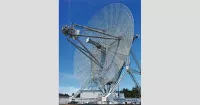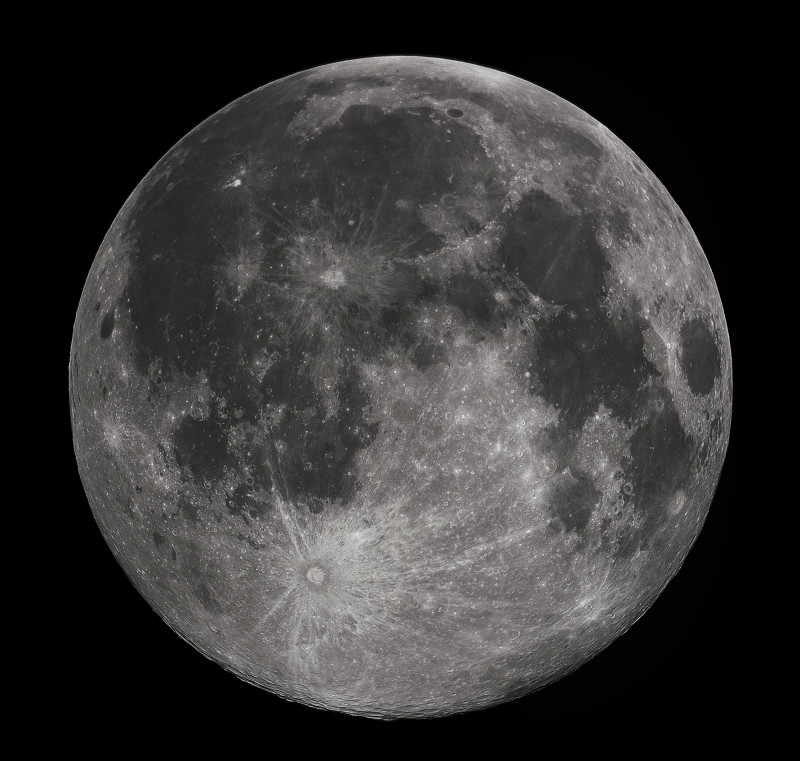The Moon is Earth's only natural satellite, orbiting at an average distance of 384,399 km. Its orbital and rotational periods are synchronized at approximately 29.5 days, resulting in it being tidally locked, presenting the same side to Earth. The Moon's gravitational influence is the primary cause of Earth's tides.
1920: Comparative Studies Lead to Lunar Stratigraphy
From 1920 to the 1940s, comparative studies of lunar craters gained support leading to the development of lunar stratigraphy, which was becoming a new and growing branch of astrogeology by the 1950s.
1957: First Spaceflight with Sputnik 1
After the first spaceflight of Sputnik 1 in 1957 during the International Geophysical Year, the spacecraft of the Soviet Union's Luna program were the first to accomplish a number of goals.
1958: Failed Luna Missions
In 1958, three unnamed failed missions of the Soviet Union's Luna program preceded successful lunar endeavors.
1959: Luna 1 and Luna 2 Reach Moon
In 1959, Luna 1 escaped Earth's gravity and passed near the Moon, and Luna 2 reached the Moon's surface by intentionally impacting it. Luna 3 also reached as the first human-made object the normally occluded far side of the Moon, taking the first photographs of it.
1959: First Objects Sent to the Moon
In 1959, the Soviet Union's Luna 1 flew by the Moon and Luna 2 intentionally impacted it, marking the first human-made objects to reach an extraterrestrial body.
1961: Kennedy's Commitment to Moon Landing
In 1961, President John F. Kennedy committed the United States to a crewed Moon landing before the end of the decade.
1966: First Soft Landing and Orbital Insertion
In 1966, Luna 9 achieved the first soft landing on the Moon, and Luna 10 became the first spacecraft to orbit the Moon.
1966: Luna 9 and Luna 10 Achievements
In 1966, Luna 9 performed a successful lunar soft landing, and Luna 10 became the first vehicle to orbit the Moon.
1968: Apollo 8 Orbits the Moon
In 1968, Apollo 8 made the first human mission to lunar orbit, following the Soviet Union's Zond 5 mission which carried the first Earthlings (tortoises) around the Moon three months earlier. Followed by turtles on Zond 6.
July 20, 1969: First Human Steps on the Moon
On July 20, 1969, during the Apollo 11 mission, humans stepped onto the Moon for the first time, landing at Mare Tranquillitatis in the lander Eagle, marking a significant milestone in space exploration.
July 21, 1969: First Human Steps on the Moon
On July 21, 1969, Neil Armstrong became the first person to set foot on the Moon, marking the culmination of the Space Race. At the same time, the Soviet Union's Luna 15 was also in orbit around the Moon, marking the first instance of two extraterrestrial missions being conducted simultaneously.
1969: Apollo 11 Landing Site Proximity
In 1969, the Apollo 11 landed near the Sea of Tranquillity which later was confirmed to be near a cave on the moon.
1969: Apollo Astronauts Place Seismometers
Starting in 1969, Apollo astronauts placed seismometers on the Moon, leading to the unexpected discovery of moonquakes.
1970: Apollo Missions Continue
Starting in 1970, five more Apollo missions landed two men on the Moon's surface, furthering lunar exploration.
1972: Seismometers Placed by Apollo astronauts
Ending in 1972, Apollo astronauts had placed seismometers on the Moon, leading to the unexpected discovery of moonquakes.
1972: Apollo 17: Last Crewed Mission
In 1972, Apollo 17 remains the last crewed mission to the Moon, marking the end of an era of human lunar exploration.
1972: Longest Stay on the Moon
In 1972, the Apollo 17 crew achieved the longest stay on the Moon, lasting 75 hours, marking the end of crewed lunar exploration for some time.
1972: Apollo 17 Mission Collects Lunar Sample
In 1972, the Apollo 17 mission collected lunar sample 74220, known as the "orange glass soil", which later was found to contain water in melt inclusions.
1973: Explorer 49 Mission
In 1973, Explorer 49 was the last dedicated U.S. probe to the Moon.
1977: End of Direct Data Transmission
In late 1977, direct transmission of data from the Apollo landing sites to Earth concluded due to budgetary considerations.
1994: Return to the Moon
In 1994, after a long hiatus, the United States returned to lunar exploration with a dedicated probe.
1994: Clementine Spacecraft Radar Experiment
In 1994, the bistatic radar experiment on the Clementine spacecraft indicated the existence of small, frozen pockets of water close to the lunar surface.
1998: Lunar Prospector Mission Data Collection
Data was collected on the 1998–99 NASA Lunar Prospector mission to find two hydrogen-rich areas.
1998: Lunar Prospector Finds High Hydrogen Concentrations
In 1998, the neutron spectrometer on the Lunar Prospector spacecraft showed that high concentrations of hydrogen were present in the first meter of depth in the regolith near the polar regions.
2006: Study of Ina Finds Young Features
In 2006, a study of Ina found jagged, relatively dust-free features that appeared to be only 2 million years old due to the lack of erosion, suggesting recent lunar activity.
2007: Models Suggest Proto-Earth Origin of Moon
Models from 2007 onwards suggest that a larger fraction of the Moon derived from the proto-Earth, challenging previous theories about the Moon's origin.
2008: Chandrayaan-1 Confirms Surface Water Ice
In 2008, the Chandrayaan-1 spacecraft confirmed the existence of surface water ice using the Moon Mineralogy Mapper, observing absorption lines common to hydroxyl.
2009: LCROSS Detects Water in Polar Crater
In 2009, LCROSS sent an impactor into a permanently shadowed polar crater, detecting at least 100 kg of water in the ejected material, further confirming the presence of water on the Moon.
2010: Lunar Cave Discovery
In 2010, analysis of photos taken by NASA's Lunar Reconnaissance Orbiter confirmed the presence of a cave on the Moon near the Apollo 11 landing site, identified as an entry point to a collapsed lava tube.
May 2011: Water Found in Lunar Sample 74220
In May 2011, 615–1410 ppm of water was reported in melt inclusions in lunar sample 74220, the "orange glass soil" collected during the Apollo 17 mission.
2016: Hydrogen-Rich Areas Found on Moon
In 2016, planetary scientists found two hydrogen-rich areas (likely former water ice) on opposite sides of the Moon using data from the 1998–99 NASA Lunar Prospector mission, suggesting they were the Moon's poles before it was tidally locked.
August 2018: Definitive Evidence of Water-Ice
In August 2018, analysis of the Moon Mineralogy Mapper (M3) data revealed "definitive evidence" for water-ice on the lunar surface, with distinct reflective signatures, particularly in permanently shadowed craters on the South Pole.
2018: Water Ice Confirmed in Shadowed Areas
In 2018, using the Moon Mineralogy Mapper's reflectance spectra, indirect lighting confirmed water ice within 20° latitude of both lunar poles in shadowed areas.
October 2020: Molecular Water Detected on Sunlit Surface
In October 2020, astronomers reported detecting molecular water on the sunlit surface of the Moon by several independent spacecraft, including the Stratospheric Observatory for Infrared Astronomy (SOFIA).
2022: High-Resolution Simulations on Moon Formation
In 2022, a study using high-resolution simulations found that giant impacts can immediately place a satellite with similar mass and iron content to the Moon into orbit far outside Earth's Roche limit, with some surviving partial stripping.
November 1, 2023: Remnants of Theia Inside Earth
On November 1, 2023, scientists reported, based on computer simulations, that remnants of Theia, the hypothetical celestial body that collided with Earth, could still be present inside the Earth.
Mentioned in this timeline

John F Kennedy JFK was the th U S President...
The United States of America is a federal republic located...

Radar is a radiodetermination system using radio waves to detect...
The Union of Soviet Socialist Republics USSR existed from to...
NASA the National Aeronautics and Space Administration is an independent...

A camera is an instrument for capturing and storing images...
Trending

2 months ago Cowboys Rumored to Target Maxx Crosby in Potential Trade with Raiders.
4 months ago Matt Chapman to IL with hand inflammation; Giants recall Landen Roupp.

7 months ago Chris Olave Trade Rumors Surface Amidst Derek Carr's Retirement and Eagles Interest
2 months ago The Rainmaker Season 1 Finale: Deaths, Breakups, and Trial Outcomes Explained.
9 months ago Regal Cinemas: New Bronx Theater Opens, Round Lake Plans Emerge, $3 Screenings Offered!
Niger is a landlocked country in West Africa bordered by seven other nations With a land area of nearly million...
Popular

XXXTentacion born Jahseh Dwayne Ricardo Onfroy was a controversial yet...

Ben Shapiro is a prominent American conservative political commentator media...

Candace Owens is an American conservative political commentator and author...

William Franklin Graham III commonly known as Franklin Graham is...
The Kennedy Center Honors are annual awards recognizing individuals and...

Stranger Things created by the Duffer Brothers is a popular...
